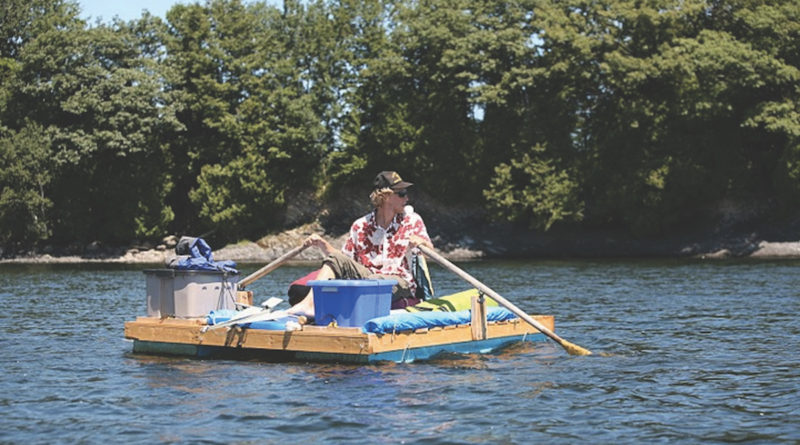Rediscovering Lake Champlain
By Leath Tonino
My teenage summers were spent working at the Charlotte Town Beach. I say “working” but the job was really a non-job: I sat in a lawn chair in a gravel parking lot—no shirt, no shoes, no problem—and collected two dollars from every car that wanted to park. During the best shifts (which were most shifts), few cars came and I was free to meditate on the vast, dimpled surface of our nation’s sixth-largest lake. That, and swim, snorkel, skip stones, watch ducks, study the clouds, and space way the heck out.
One evening, the sky a fireworks of sunset colors, I was closing up shop (how do you close up a beach?) when I noticed there wasn’t a single boat—motorboat, sailboat, rowboat, whatever—anywhere to be seen. The massive lake at this moment of its greatest serenity was vacant, overlooked, underappreciated. That’s when the vision came to me: I will build a raft! I will become an explorer of the glassy emptiness that is the symbol and centerpiece of my home! Call me Samuel D. Champlain for the 21st century! Call this voyage the rediscovery of Lake Champlain!
It’s worth mentioning that as a tyke I’d been a pretty serious designer of inner tube rafts. This “adult” raft, though, was to be something sturdier (though admittedly just as goofy and experimental). Yes, this raft was to get me all the way from the lake’s southern terminus to the Canadian border, 100-plus miles of waves, bass and shooting stars. I called my project Raft Life—I would live on the very surface of the lake. The raft would be my kitchen, my bed, my exercise and transportation and entertainment. It would be a door opening onto wonders and mysteries. As Thor Heyerdahl writes in his classic of raft literature, Kon-Tiki: “The sea contains many surprises for him who has his floor on a level with the surface and drifts along slowly and noiselessly.”
So I bided my time, nurtured the vision, and a few years later spent the month of June scratching my chin with a hammer in hand (potentially dangerous), wondering how I was going to construct the floating home of my dreams. Had anybody ever tried such a thing on Lake Champlain? Apparently not. There were no blueprints for Raft Life. Then again, as Poppa Neutrino, a famous raft-weirdo who crossed the Atlantic on a junk heap cobbled together from dumpster gleanings, once said: “There are things I don’t know, and can’t know until I’m on the ocean, but if I knew everything already, there wouldn’t be any adventure.”
By the first of July I had fashioned pine planks and marine-foam pontoons into a floating dock of sorts—seven feet long by five feet wide. It was snug, sure, but there was plenty of room for a tarp-tent, oars, a square sail, an anchor, a hibachi grill, a fishing pole, binoculars, a life jacket and books by Plato and Shakespeare (my first and second mates, as it were). My parents and I trailered the raft two hours south of Ferrisburgh, dropped it in the water, popped a bottle of bubbly for christening purposes, and off I went. It was dusk, a lovely evening. Cormorants spread their wings from perches on shoreline trees as if in greeting, as if welcoming me to their world.
All in all, I spent over three weeks on the lake, leaving my raft only to go to the bathroom or—if I smelled hamburgers—make new friends at a state park barbecue. At the risk of sounding hyperbolic, I will declare that it was the greatest thing I’ve ever done. Period. Never have I experienced more natural beauty than on that voyage. Never have I had more intimate encounters with wildlife. Never have I interacted with more kind-hearted strangers: beers with fishermen, ice cream sundaes with grandmas, a job offer at a marina, an English teacher who stood in the rain on a pier and shouted Huck Finn quotes to inspire me onward (“We said there warn’t no home like a raft, after all. Other places do seem so cramped up and smothery, but a raft don’t. You feel mighty free and easy and comfortable on a raft.”) A pair of sisters drew pictures of me in crayon and got their father to paddle the portraits out in his kayak. Another time—no, multiple times, actually—I was told that I was a “hero.” It was utterly unexpected, as if my quirky, humble raft was a magnet attracting the best in people.
Lake Champlain is, duh, not the Arctic nor the Amazon. It is not a humongous wilderness. Rather, it is a sociable, human space (cottages, kids getting whiplashed around on tubes) that retains certain wild characteristics (thunderstorms, immense solitude). This dovetailing of worlds, I’ve come to understand, is what made Raft Life so special. The voyage really was an exercise in a new type of exploration—the exploration of the everyday, of the local, of home. Like I said: Samuel D. Champlain for the 21st century.
Years have passed, as they will, and now I’m older. The raft is still with me, though, still a cherished friend. From time to time I hop on, feel the soft wooden oars in my calloused hands, and start the rediscovery all over again. The lake, it turns out, is both finite and infinite. The lake is discovered, undiscovered, forever both at once.
Leath Tonino is the author of the forthcoming book, The Animal One Thousand Miles Long about his explorations in Vermont.


Pingback: Raft Reading: Your Summer Book List - Vermont Sports Magazine